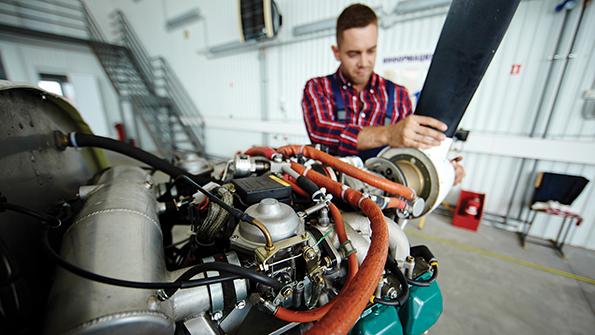
The shortage of professional pilots, long a subject of dire warnings, seems to have arrived. Now that pandemic restrictions are easing and passengers are returning, some airlines are having difficulty satisfying that influx, partly because of the insufficiency of flight deck crews.
The carriers are addressing the problem in multiple ways: better compensation and scheduling to retain pilots already on their rosters, wholesale raiding of regionals and business aviation flight departments, signing bonuses, sponsoring ab initio training programs and teaming with aeronautical colleges. For those holding Air Transport Pilot certificates, the future looks to be the bluest of blue skies.
There remains, however, another roster with too many blank spaces. That should be as concerning to the industry as the pilot depletion since airplanes must be maintained regularly and repaired when they break, as all machines do. The people charged with “keeping ’em flying” are airframe and powerplant (A&P) certificate holders—aka, mechanics—and avionics technicians, whose numbers are declining just as business aviation booms and airlines rebound.
Why? The reasons I’ve been given are cultural, economic, systemic and, well, other.
To begin, many opine that the nobility of working with one’s hands seems out of favor. Ryan Waguespack well remembers his high school guidance counselor’s response when he told her that he had no interest in a college education and wanted to begin working in aviation. Her reaction, he recalls, “was negative,” with “the overtone [that] I was not going to be a success in life.”
Similarly, Curtis Boulware observes that rather than being encouraged to pursue trades, kids “are told to go to college and learn psychology.”
However, after earning his A&P in 2000, Boulware started working full-time at George Baker Aviation Inc. in New Smyrna Beach, Florida. Eleven years later, he bought the service business, which employs 13 people, including nine A&P technicians, and is looking for more.
Meanwhile, Waguespack entered the University of Alabama at Birmingham—and he also began pilot training. Before long, he’d begun his own flight school and served in various roles for charter/management companies and in aircraft sales. He founded the Alabama Business Aviation Association. Today he is executive vice president of the National Air Transportation Association, and he often speaks to college audiences promoting aviation careers.
Regarding economics, Boulware says his outfit offers newly minted A&Ps $22-23 per hour plus a full benefits package and increased pay with experience. However, he and others note that the airlines not only offer more but have formalized training programs with clear paths to career advancement and stability, something largely absent in general and business aviation.
Sheryl Barden, who is president of Aviation Personnel International and a member of the National Business Aviation Association’s advisory council, emphasizes the need for structured instruction and technical skills acquisition in the nonairline world. And Waguespack says instruction needs to reflect current circumstances, be aircraft-specific and be provided on the job. “Why are we still teaching dope and fabric repair?” he asks. “Today, you’re working on computer systems.”
Barden also notes that business aviation maintenance departments are often tasked with such a variety of mechanical, electronic and computational responsibilities, among other things, that the technicians can be overwhelmed—not a condition that enhances job satisfaction and employee retention.
Because of the foregoing, combined with COVID-19 restrictions, long lead times, parts scarcity and consequent fiscal struggles among some smaller shops, significant numbers of experienced technicians—a “massive pool of knowledge,” Waguespack says—are choosing to retire, and successors are slow to appear. Indeed, many new tech grads choose to work in nonaerospace industries, including servicing theme parks.
The solution? “I wish I knew,” Boulware says. Waguespack’s assessment: “We didn’t get here overnight, and we’re not going to get out overnight.”
Any fix will have to be multifaceted, including a societal appreciation of hard, disciplined work employing tools and brains; an industry system of career entry, practical education and advancement; clear division of work responsibilities; and compensation levels that assure financial security. That’s a lot, but it is what may be required to keep ’em flying.



Comments